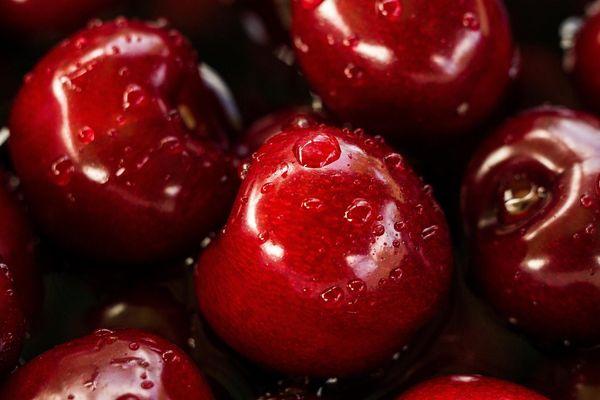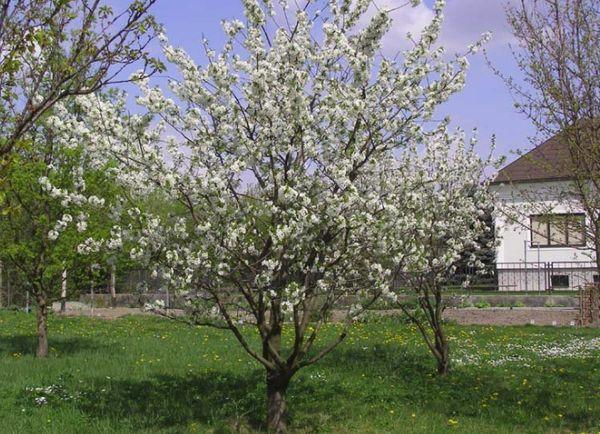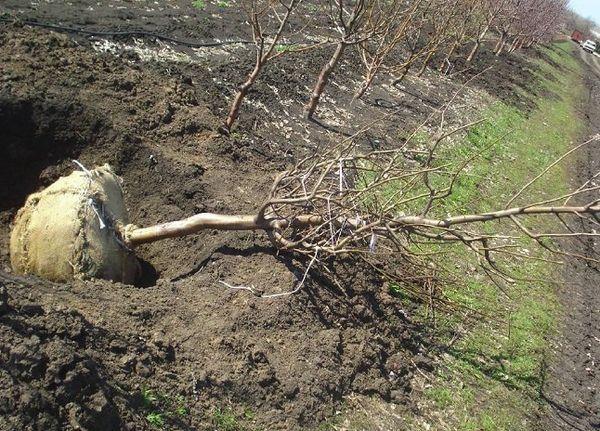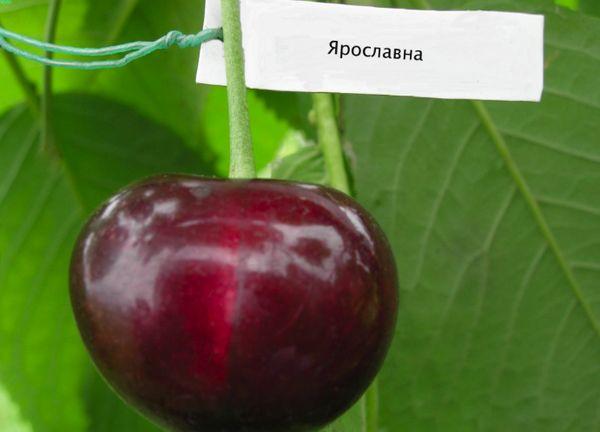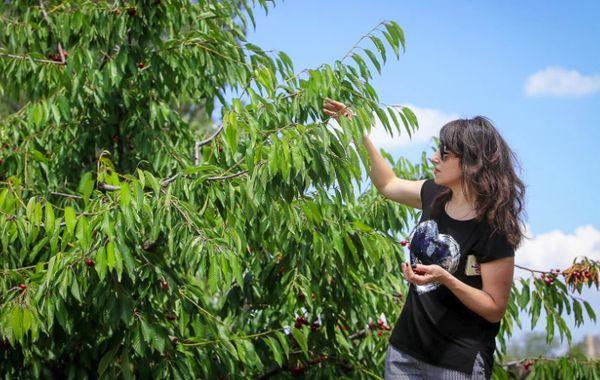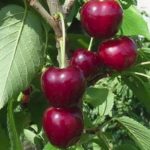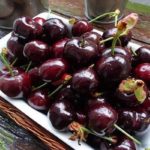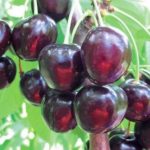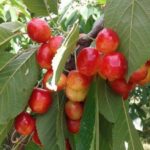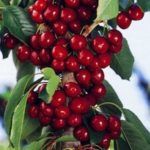The Yaroslavna variety of cherries is famous for its excellent taste and ease of care. The variety ripens early, the tree can withstand persistently low temperatures and resists diseases. This is one of the most popular types of Ukrainian selection of cherries, which is appreciated even by inexperienced summer residents. You should first familiarize yourself with all the nuances of the tree.
- How the variety was bred
- General description of the tree
- Pros and cons of cherries
- Berries
- The period of tree flowering and cherry ripening
- Drought resistance
- Frost resistance
- Tree disease resistance
- Basic soil requirements
- Features of planting a tree
- Selection of seedlings
- Site preparation
- Pit preparation
- Planting a tree
- Tree pollinators
- Secrets of caring for wood
- Watering a tree
- Trimming scheme
- Preparing a tree for winter
- Fighting diseases and pests
- Treatment of bacterial cancer in a tree
- Reviews about the cherry variety
How the variety was bred
Cherry variety Yaroslavna was bred in the 1970s of the last century by breeder L. Taranenko. The species was obtained from seedlings of Drogana yellow in the Donetsk branch of the University of Horticulture UAAN. The variety of cherry tree immediately became popular in its homeland, and later gained recognition in the countries of the former USSR.
General description of the tree
The tree grows of medium height, with a round bush of medium density. The branches are spreading, arched, thick, brown in color. The leaf blade is medium-sized, egg-shaped, dark green in color. The corolla of the flower is white, 3 cm in diameter. The tree grows up to 3.5 meters high. When in bloom, the garden is decorated with snow-white and pinkish flowers, creating a romantic atmosphere.
Pros and cons of cherries
The Yaroslavna cherry variety suggests a number of positive and negative traits. Getting to know them will help you assess the situation and make a choice. The negative aspects can be easily mitigated if you properly care for the tree.
| pros | Minuses |
| Resistance to frost and dry periods | The tree has low resistance to fungal infections |
| Fruits are easy to transport | Pollinators required |
| Every year the tree produces a lot of fruit | |
| Fruits do not crack |
Berries
The cherry is large, slightly tapering towards the top, dark red in color. The stone is small in size and easily separated. The weight of one cherry is 7-8 grams. The pulp is juicy, dark scarlet, sweet. It contains 13% dry elements, almost 10% sugar, 9 mg/% vitamin C, and also contains iron, vitamin P, copper, and carotene. The fruits received a tasting score of 4.9 points and tolerate transportation well.They are consumed fresh or prepared for the winter. They widely prepare jams, jams, compotes, add cherries to baked goods or decorate fruits with them.
The period of tree flowering and cherry ripening
An early ripening cherry variety begins to bloom at the end of May, the berries ripen by the end of June or beginning of July. The tree bears fruit 4-5 years after planting; up to 20-30 kg of cherries can be harvested from one specimen. Peak yield is observed after 10 years of crop life. With good care, a maximum of 100 kg can be harvested from a tree. The variety is perfect for growing for personal consumption or sale. It is widely grown on industrial sites.
Drought resistance
The cherry tree normally tolerates dry periods, but if they are not long-term. The crop loves moisture; in the absence of the proper amount of watering, the number of fruits decreases, the plant loses its ability to resist diseases and attacks of harmful beetles.
Frost resistance
The cherry variety can withstand up to 36 degrees of frost, but for a short time. If there are long-term frosts in the region, the plant should be covered with oxygen-permeable materials. Otherwise, freezing of the crown, trunk, and deterioration of the condition of the tree is possible.
Tree disease resistance
Cherry Yaroslavna has a strong immune system, but only if you take diligent care of it. The plant is resistant to coccomycosis, and fungal infections sometimes attack the crop.
Basic soil requirements
The cherry variety prefers to grow in fertile, slightly moist soil. The plant does not tolerate close groundwater or increased soil acidity. If the acid level is less than 7.0, liming of the soil is required. You will need 7-10 kg per planting hole. Buy lime in advance.
Features of planting a tree
Cherries are planted in the southern regions in the fall. In warm areas, the seedling has time to develop a root system before the arrival of cold weather. If we are talking about the middle or northern zone, it is better to plant the crop in the spring, in early March, before the sap flows. Then the cherries will be protected from frost, the rhizome will have time to form before the next season. It is important that the air temperature is stable from 10 degrees Celsius, and there are no night frosts.
It is advisable to plant cherry planting material 3-4 weeks before or after frost. The place should be well-lit, without drafts. The distance between trees should be 3.5-4 meters, since the variety has a wide, dense bush that creates shade.
Selection of seedlings
It is better to purchase cherries in the fall, then there is more choice of planting material. Make purchases from nurseries or professional breeders. Purchasing a seedling on the market from unverified sellers risks getting a wild tree or the wrong variety. The seedling must be one year old, consist of 5-6 branches, one conductor.
Pre-inspect the seedlings for integrity, absence of damage, healthy rhizomes. There should be no damaged areas or dried out areas. There must be a grafting site on the plant. When transporting, wrap the cherries in a wet cloth and wrap cling film on top.
Site preparation
3 weeks before planting, the plot should be prepared. It is necessary to add mineral fertilizers to the soil and mix them with the soil. Weed the soil, it should be saturated with oxygen.
Pit preparation
2 weeks before the planned planting, they dig a hole 0.6-0.7 meters deep. 3-5 buckets of water are poured into it, fertilizers such as manure or compost are added.In 14 days, the soil will settle and the plant will take root better.
Planting a tree
In order for seedlings to grow and develop quickly, you should adhere to the following planting rules.
- In a pre-dug hole, separate the top layer of soil from the bottom.
- Drive a 1.5 meter high stick into the center.
- Combine the top layer of soil with a combination of fertilizers - 7-8 kg of compost, 180-200 g of superphosphate, 60-80 g of potassium sulfate, 450-500 g of wood ash. Form a mound around the installed support.
- Dip the rhizome of a young tree in a clay mash, straighten it, place it in a recess on the formed mound next to a stick.
- Sprinkle the root system with soil, compact it tightly layer by layer so that there are no gaps.
- Tie the seedling with twine to a figure eight peg.
- The distance from the surface of the earth to the rhizome after planting should be 4-5 centimeters.
- Form a hole along the tree trunk with a diameter of 50-60 cm.
- Water the tree with 2-3 buckets of water, mulch with sawdust in a layer of 5-7 cm.
The root collar of the plant should be flush with the ground surface.
Tree pollinators
In order for cherry ovaries to form successfully, planting nearby pollinators is required. Such trees include:
- Donetsk beauty;
- Donchanka;
- Valery Chkalov;
- Annushka;
- Drogana yellow;
- Aelita;
- Ethics;
- Melitopol early.
It is undesirable for the cherry varieties Early Rozovinka and Sis to be near cherries. Pollinator trees should be located in the garden no more than 50 m from Yaroslavna, if possible, on different sides from it. It is better that these are plants of the same age, or older, but not young.
Secrets of caring for wood
Caring for a tree is simple; it is only important to prune it on time, fertilize the soil, and fight diseases or pests if necessary. Proper care of cherries will give you a gorgeous, abundant harvest, the fruits will be juicy and presentable in appearance.
Watering a tree
Cherries should be watered generously when the berries are setting and when they ripen. Irrigation is carried out 3-4 times during the growing season. In the fall, moisture-recharging irrigation is carried out before sheltering for the winter. The calculation of water for one tree is 1-2 buckets. First, loosen the soil in the tree trunk circle and mulch. The water should be warm.
Trimming scheme
It is advisable to form cherries in 3 or 4 bushes. To prevent gum development, perform circumcision only in weather without precipitation, in June. The stem is formed at least 60 cm. The branches are cut by 1/3 or half, the outer buds are removed from the side shoots, and shortened by one length.
Leave the main shoot, the conductor, 20-30 cm longer. Subsequently, you will need to shorten the branches every year, this will restrain the growth of the cherry and stimulate productivity. If pruning is done in mid- or late summer, the tree may dry out, become diseased, or die.
Carry out the work with disinfected pruning shears so that pathogenic agents do not enter the plant. In March, it is better not to prune frozen branches, but to do it in May, when dry weather sets in. Treat the cuts on the tree with garden varnish.
Preparing a tree for winter
For the first time, experienced gardeners recommend covering or tying young trees. If there are cracks on the trunk, treat them with garden varnish.
Before covering, prepare the cherries:
- remove all damaged, dry branches;
- the tree trunk area is cleared of weeds and fallen berries;
- the ground is dug up, watered, mulched with sawdust or peat;
- the trunk is wrapped in nylon or burlap.
Cherries can still be protected from frost by whitewashing, which is done in early spring as high as possible, about 1.5-2 meters. You need to touch trunks and skeletal branches.
Fighting diseases and pests
Cherry Yaroslavna rarely suffers from diseases, pests, or bird attacks, but if this happens, take sanitary measures. They are in the following aspects:
- to protect the crop from birds, pull fishing nets over the bushes or place scarecrows;
- if the tree is sick, treat it with Bordeaux mixture 1%, Hom, Horus, Topsin, Nitrophen;
- Pests are eliminated by using ZOV insecticides.
As preventive measures, eliminate water stagnation, trim the tree in a timely manner, and fertilize the soil.
Treatment of bacterial cancer in a tree
Bacterial cherry canker attacks trees between 3 and 8 years old. The disease assumes a bacterial etiology. The pathology is preceded by a wet, cold spring with frequent showers and winds. It manifests itself this way:
- the branches are covered with cankers from which gum flows;
- specks of a brownish tint with a yellow border appear on the leaves and berries;
- fruit stalks become covered with small brown ulcers;
- the wood dies, the foliage dies.
Cherries usually don't survive. Bacteriosis can be asymptomatic if the summer is warm and without precipitation. There are no methods of treatment for this disease. Some gardeners advise resorting to pruning diseased branches, cutting out affected areas in the bark, and treating with copper sulfate.
Such treatment techniques rarely give positive dynamics.If the disease is at an early stage, perhaps a therapeutic regimen will be relevant. When the cancer is advanced, it is impossible to cure cherries. The pathological process develops in trees that are regularly fertilized with nitrogen and watered moderately.
Reviews about the cherry variety
Feedback about Yaroslavna cherries is mostly positive. They will help you evaluate the variety realistically.
Kristina Ostapets, 35 years old, Kyiv.
Hello! In 2013, I planted Yaroslavna cherries on the plot. The plant is unpretentious in care, which is good for summer residents. I had 3 such trees on my site, from which I collected 15 kg of fruit. Cherries are always sweet, juicy, without sourness. I recommend this variety to everyone.
Pavel Lavrentiev, 58 years old, Kazan.
Greetings! I have been interested in gardening for 10 years. Yaroslavna cherries have been growing in my garden since 2010. The tree ripens early, by mid-June. Cherries are always juicy; I treat them to my work colleagues and make excellent compotes. The plant never got sick, although it was attacked by weevils. I destroyed them in 2 approaches using chemicals. I am completely satisfied with the culture, I recommend it to everyone!

